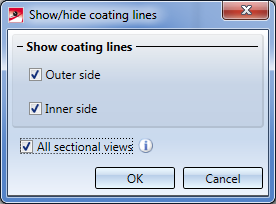Dialogue Window for Sectional Views
You make the settings for sectional views in the New sectional view dialogue window, which is displayed automatically when you call the Sectional view function.
These are:
- Type of the sectional view
- Sketch for the section path
- Representation of sectional views
- Hatching
- Coating
Type of the sectional view
![]() With parts in background
With parts in background
The view is displayed as a solid.
![]() Only
cut surface
Only
cut surface
A sectional view is created in which only the cut surface is displayed.
![]() With depth limitation
With depth limitation
If this option is active, the depth of the section does not extend over the entire drawing, but the cutting depth is explicitly determined by the specified value. The value for the depth determines the distance from the cut surface up to which parts are to be represented.
If the ![]() Unfolded checkbox is additionally active, all cut surfaces are unfolded into a common plane. This is useful, for example, if you want to display the inner sides of revolved parts, pipes, etc. In addition, non-unfolded views can be limited laterally, so that the section object does not penetrate the drawing entirely.
Unfolded checkbox is additionally active, all cut surfaces are unfolded into a common plane. This is useful, for example, if you want to display the inner sides of revolved parts, pipes, etc. In addition, non-unfolded views can be limited laterally, so that the section object does not penetrate the drawing entirely.
You can limit non-unfolded sectional views laterally by activating the ![]() Limited checkbox. In this case the view would be a combination of a sectional and a detail view. After closing the dialogue window for sectional views the dialogue window for detail views is displayed automatically. Here you can specify the scale and the hatching parameters.
Limited checkbox. In this case the view would be a combination of a sectional and a detail view. After closing the dialogue window for sectional views the dialogue window for detail views is displayed automatically. Here you can specify the scale and the hatching parameters.
 If you want to change the lateral limitation of a sectional view subsequently, use the Change detail view function. This function displays the automatically created limiting frame as a sketch. You can change this sketch subsequently, i.e. move or rotate it.
If you want to change the lateral limitation of a sectional view subsequently, use the Change detail view function. This function displays the automatically created limiting frame as a sketch. You can change this sketch subsequently, i.e. move or rotate it.
 If a sketch that has been parameterised with HCM constraints contains variables, these will automatically be defined as variables of the view. When using the sketch in a detail view, a sectional view or a cut-out. If you then change the value of the view variables, all views of the current drawing will be updated and the corresponding detail views, sectional views and cuts-outs will be adjusted accordingly. The original sketch, however, remains unchanged. This means that you can adjust view fast and easily without having to change the corresponding sketch.
If a sketch that has been parameterised with HCM constraints contains variables, these will automatically be defined as variables of the view. When using the sketch in a detail view, a sectional view or a cut-out. If you then change the value of the view variables, all views of the current drawing will be updated and the corresponding detail views, sectional views and cuts-outs will be adjusted accordingly. The original sketch, however, remains unchanged. This means that you can adjust view fast and easily without having to change the corresponding sketch.
Sketch for the section path
The path of sectional views is based on a 3-D sketch. This may be available in the drawing or be newly created when defining the view.
|
|
New sketch |
Activate this icon to create a new sketch. |
|
|
Select sketch |
Activate this icon if you want to use a sketch that is available in the drawing. Then identify the relevant sketch. |
|
|
Delete after creation |
The sketch used is preserved even after the sectional view has been created. |
|
|
The sketch used is deleted after the sectional view has been created. |
Please also read the notes on the purposes and representation of sketches. Sketches with the purpose Part will be cut in sectional views, sketches with the purpose Create/Edit will not be cut.
Representation of sectional views
|
Option |
Effect |
|---|---|
|
|
The section path is identified. Additionally, the annotation or angle description is displayed. |
|
|
The section path is identified in the active view by means of arrows at the start and end points of the section. The sectional view itself does not contain any identification. |
|
|
Start and end points of the section path are identified in the active view by means of the same letter combination. A corresponding text is entered into the view. The annotation is used automatically also as the name of the sectional view. |
|
|
Start and end points as well as the point on the path are identified consecutively by means of letters in the active view. A corresponding text is entered into the sectional view and the direction determined by HiCAD based on the section contour is identified by means of an arrow. The angle description is used automatically also as the name of the sectional view. |
|
|
Start and end points as well as the point on the path are identified in the active view by means of the same letter and a consecutive number. A corresponding text is entered into the sectional view and the direction determined by HiCAD based on the section contour is identified by means of an arrow. The angle description is used automatically also as the name of the sectional view. |
|
|
Use this button to specify the representation of the section in the original view (source view). These are: Font, font colour, text height, the representation of the section path, the position of the annotation at the section path, and the line type, line colour and the layer. When you click the button, the following dialogue window will be displayed:
Left: Position of annotation on lengthening of section path; Right: On arrow
Different representations of the section path
When this function is selected for the first time in the current drawing the default settings in the window are those specified in the Configuration Editor. To change these settings, open the Configuration Editor and select Drawing > Views > Ident > Sections. When you call the function again, the last used text and line parameters will apply. |
|
|
* You can apply or reverse the flow direction. To do this, activate/deactivate the Reverse direction checkbox. |
|
|
The preview button enables you to check and, if required, change the selected ID before the sectional view is created. |
|
|
If you want a caption for the sectional view to be generated, activate the checkbox and then the entries that you want to copy to the caption. If, for example, the sectional view is not derived in the alignment direction, activate the arrow and, if required, the angle. If you want to define an individual caption for the view, click the The caption is automatically centred above the view. If desired, however, you can move the caption. For captions in sectional views the template file VIEWHEADER_S.FTD in the HiCAD sys directory is available. Use this file to individually configure the captions in sectional views. When you create a new sectional view, the caption will be composed of the settings selected in the template file, the view designation and the caption components Scale, Arrow and Angle chosen in the dialogue window for sectional views. An example: The following setting has been saved for the template file VIEWER_S.FTD:
A sectional view with the settings shown below will be created. The sectional view will then, e.g. have the following caption:
By default, the FTD file is initially empty.
Please note that these settings do not apply to headings (captions |
Hatching
You can also display the section surfaces of a sectional view with hatchings.
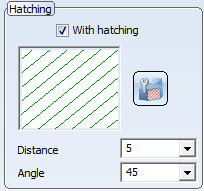
To obtain a hatched display of the section surfaces, proceed as follows:
- Activate the With hatching checkbox. The current hatching setting is displayed.
- Select a different hatch pattern if necessary. Click on the Change hatching
 icon. The Hatch selection dialogue window is displayed. If you point the cursor on one of the patterns, more information about the hatch pattern is displayed. You can also zoom the display of the patterns by clicking on the magnifying glass symbol in the lower left corner.
icon. The Hatch selection dialogue window is displayed. If you point the cursor on one of the patterns, more information about the hatch pattern is displayed. You can also zoom the display of the patterns by clicking on the magnifying glass symbol in the lower left corner.

Select the desired pattern and confirm with OK.
- Specify the hatching line spacing and angle.
 The hatching of the cut surface is influenced by the setting that has been selected for the cut surface hatching parameter in the Configuration Editor at Drawing > Views. If the Cut surface hatching parameter is set to According to material, the hatching selection in the dialogues has no effect.
The hatching of the cut surface is influenced by the setting that has been selected for the cut surface hatching parameter in the Configuration Editor at Drawing > Views. If the Cut surface hatching parameter is set to According to material, the hatching selection in the dialogues has no effect.
Coating
For Sheet Metal parts you have now the option to specify whether the coating in the sectional view is to be shown or not, by activating or deactivating the Display checkbox beneath Coating in the dialogue window. The coating is displayed in the form of an offset edge, the so-called "coating line". The settings for the representation of the coating line can be found in the Configuration Editor at Drawing > Annotations > Coating line in sectional view.

The representation of the coating line can also be changed subsequently. To do this, right-click on the coating line in the required view and choose the desired function in the Coating symbol context menu:
|
Function |
|
|---|---|
|
|
Change coating line parameters Use this function to change the colour, line type and layer of the coating line. When you call the function, the 3-D edge parameters dialogue will be displayed for this purpose. |
|
|
Change offset distance Use this function to change the offset distance, i.e. the distance between coating line and cut edge. |
|
|
Show/hide coating lines Coating lines can be hidden or shown in the active view or in all sectional views. One distinguishes between coating lines on the inner side and the outer side. When you call the function, the following dialogue window will be displayed:
With the settings shown above, the coating lines will be shown in all sectional views on the outer side and inner side. If all coating lines have been hidden, the lines can be redisplayed again via the context menu for sheets: In the sectional view, right-click the sheet and choose Properties > Coating line. |
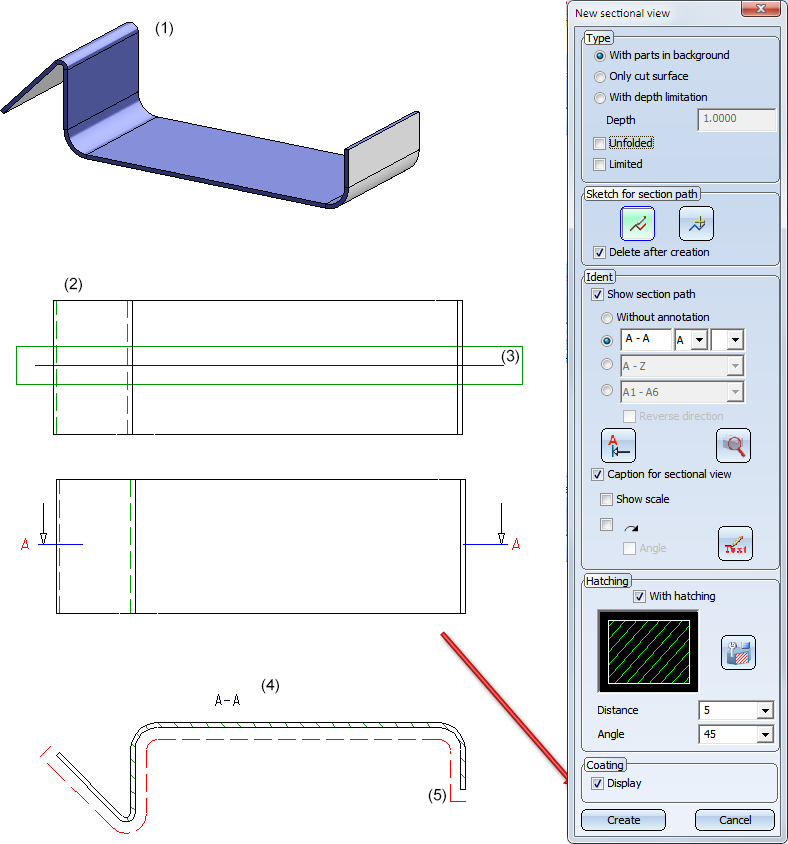
Sheet Metal part (1) with outside coating; Top view (2) with cut edge (3), Sectional view (4) with coating line (5)
 Please note:
Please note:
- The offset calculation for the coating lines is always carried out in the screen plane, i.e. the lines are no "fixed", permanent 3-D polylines, but will be updated upon rotation of the view.
- In dashed representations the dashing takes place segment-wise, but not over the entire length.

Special Views (3-D) • Sectional and Detail Views (3-D) • Views (3-D)




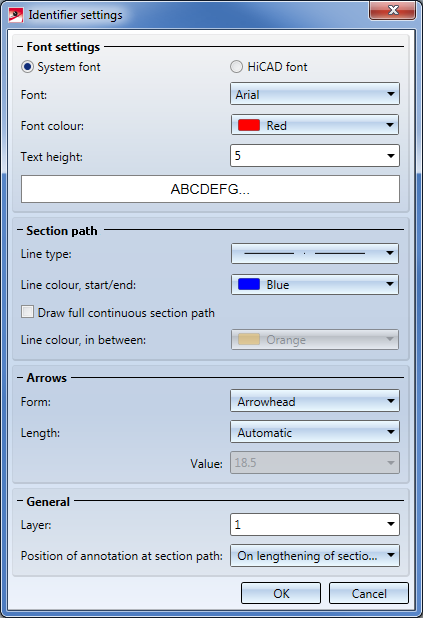
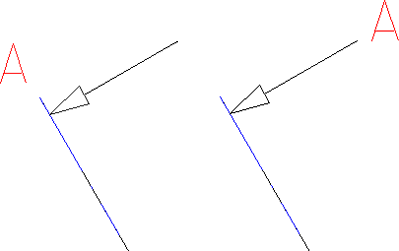

 Reverse direction
Reverse direction
 icon. The
icon. The 





